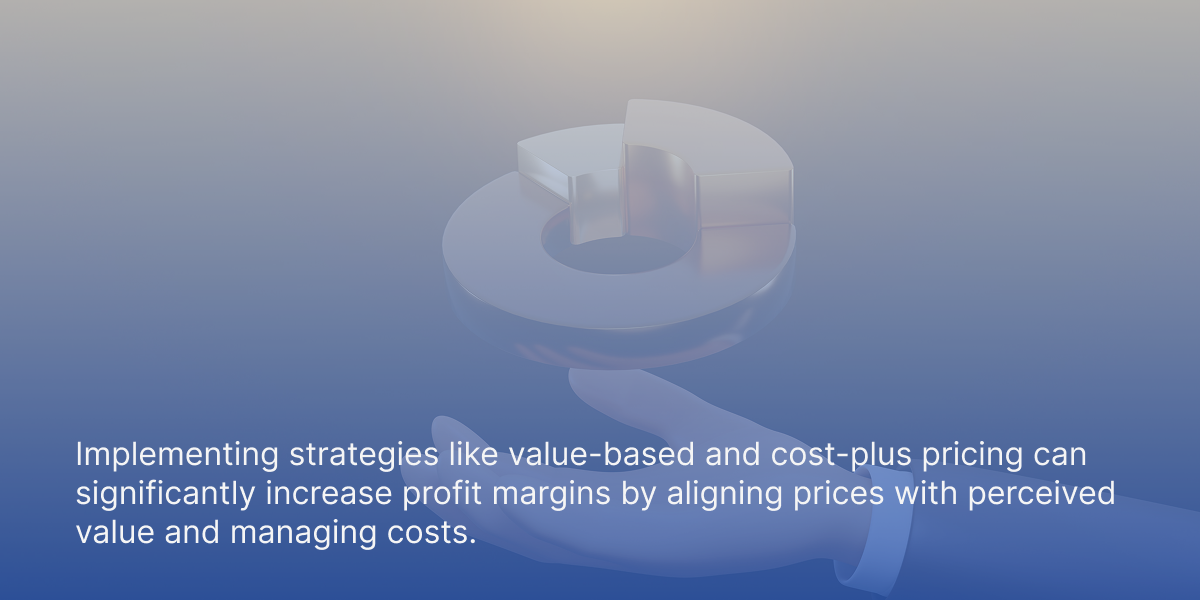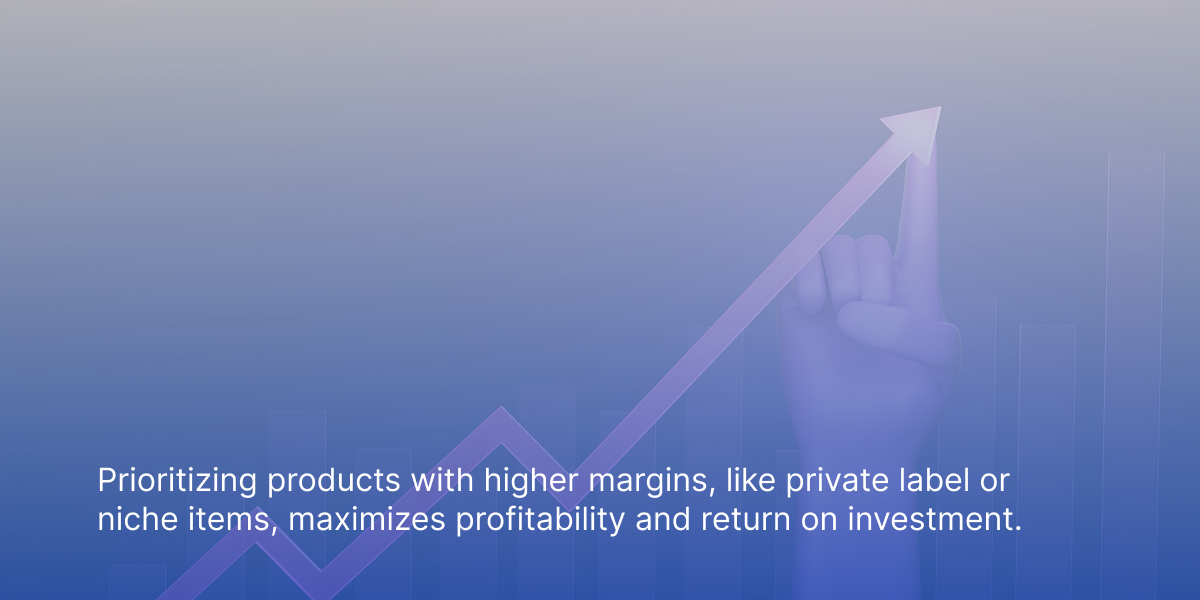Looking to learn how to increase profit margins? This article outlines key strategies to help you achieve that. From optimizing pricing to enhancing operational efficiency, discover actionable steps to boost your bottom line.
Key Takeaways
- Profit margins are essential for assessing business profitability and can be improved through strategies like optimizing pricing and reducing operating costs.
- Many businesses benefit from enhancing operational efficiency, effective inventory management, and focusing on high-margin products, as these strategies have broad applicability and can significantly increase profit margins.
- Regularly monitoring financial health and employee engagement are critical for sustaining profit margins and fostering long-term business stability.
Understanding Profit Margins
Profit margins are the backbone of any business, reflecting the company’s earnings compared to its revenue. Three main types of profit margins exist:
- Gross profit margin: Assesses profitability based on revenue minus the cost of goods sold. Understanding the company’s gross profit margin is essential for assessing production efficiency and pricing strategies. This metric helps businesses understand how efficiently they are producing and selling their products, impacting their company’s gross profit margin, good profit margin depends, good gross profit margin, gross profit margins, ideal profit margin, and company’s profit margin.
- Operating profit margin
- Net profit margin
Operating profit margin includes operating expenses, providing a more comprehensive view of how well a company manages its day-to-day operations and its operating margin. Finally, the average net profit margin takes into account all expenses, including taxes and interest payments, offering a complete picture of a company’s profitability. Net margin is calculated by deducting all expenses, including taxes and interest payments, from total revenue. A higher profit margin typically indicates better efficiency in managing costs and pricing strategies.
A robust profit margin helps businesses weather economic uncertainty and fund strategic investments. Profit margin is important because it shows how much profit a company retains from its revenue, and is a key indicator of the company’s profitability. Improving profit margins enhances overall profitability and resilience, setting your successful business on the path to lasting success and stability. Understanding how much profit is generated from each sale helps businesses make informed decisions. Efficient production and sales directly impact the company’s profit margin and overall company’s profitability.
Setting Business Goals
Setting clear business goals is a foundational step in improving profit margins and driving overall business profitability. By defining what you want to achieve—whether it’s increasing revenue, reducing operating costs, or enhancing customer satisfaction—you create a roadmap for success. The most effective goals are specific, measurable, achievable, relevant, and time-bound (SMART), ensuring your team is aligned and focused on tangible outcomes.
Establishing business goals allows you to pinpoint areas for improvement in your gross profit margin, operating profit margin, and net profit margin. For example, you might set a goal to improve your gross profit by optimizing your pricing strategy or to reduce operating costs through better inventory management. Remember, a good profit margin depends on your industry, business model, and target market, so it’s important to benchmark against industry averages and adjust your targets accordingly.
Regularly reviewing and updating your goals keeps your business agile and responsive to market changes. This ongoing process helps you make informed decisions about pricing, cost control, and resource allocation, all of which are crucial for maximizing profits and improving financial health. By setting and tracking clear business goals, you can systematically improve profit margins, reduce unnecessary expenses, and support sustainable growth.
Optimize Pricing Strategy
A well-designed pricing strategy can significantly enhance profit margins, with potential increases ranging from 2% to 7% per sale. One effective approach is value-based pricing, which focuses on the benefits a product offers and aligns prices with customers’ perceived value. Effective pricing strategies like value-based pricing can result in higher margins and improved financial strength, giving businesses a competitive advantage. This strategy not only maximizes profit margins but also promotes customer loyalty by increasing their willingness to pay.
Another method is cost-plus pricing, which adds a fixed margin to the cost of production. This straightforward approach is particularly effective in stable cost environments. Competitive pricing involves continuously monitoring competitors’ prices to ensure market relevance and optimal pricing.
Even a strategic price increase of just 1% can lead to an increase of approximately 8.7% in operating profits. Implementing these strategies can boost revenue and increased profits, overall profitability, total revenue x 100, and increase profit.
Enhance Operational Efficiency
Enhancing operational efficiency reduces costs and increases profit margins. Monitoring and controlling company spending on utilities, subscriptions, and materials is crucial for improving operational efficiency and profit margins. Automation technologies cut down on manual tasks, boosting productivity. For example, automating inventory management minimizes human error and helps control costs, crucial for maintaining profit margins.
Standardizing business processes enhances consistency, quality, and efficiency while reducing errors and saving time. Regular process reviews uncover opportunities for optimization, ensuring smooth and efficient operations. Outsourcing specialized functions can also improve efficiency and reduce costs over time.
Cross-team collaboration prevents bottlenecks from siloed information sharing. Streamlined operations meet quality standards, enhance customer satisfaction, and boost competitive edge. Focusing on operational efficiency enables businesses to achieve higher profit margins and support sustainable growth.
Reduce Operating Costs
Reducing operating costs directly improves net profit margins and can also help improve gross profit margin. Strategies to achieve this include:
- Conducting a vendor bidding process to secure better pricing for services and materials.
- Negotiating with suppliers to decrease costs and improve profit margins.
- Paying invoices early to potentially receive discounts, lowering operational costs while reducing costs.
- Regularly evaluating vendor relationships to secure better terms and reduce inventory costs.
Sustainable technology solutions offer long-term cost savings and appeal to environmentally conscious consumers. Transitioning to remote work reduces office-related costs like rent and utilities, especially in light of rising costs.
Implementing these strategies helps businesses reduce costs, maximize profits, and boost overall profitability.
Improve Inventory Management
Effective inventory management ensures optimal stock levels, prompt order fulfillment, and minimized waste. Maintaining the right inventory amount avoids excess capital tied up in unsold products. The Economic Order Quantity (EOQ) formula helps determine ideal inventory levels to meet customer demand efficiently.
Efficient management of raw materials is crucial, as it helps control the cost of goods sold and directly improves profit margins.
ABC Analysis categorizes inventory into three groups to optimize stock management and improving inventory management profitability. A perpetual inventory system enables real-time tracking of stock movements and adjustments. Enhancing inventory management reduces costs, increases profit margins, and boosts operational efficiency.
Managing Supply Chain
Effective supply chain management is a powerful lever for improving profit margins and reducing costs. By streamlining the flow of goods from suppliers to customers, businesses can significantly lower direct costs, labor costs, and indirect costs associated with production and delivery. A well-managed supply chain not only reduces the cost of goods sold but also enhances operational efficiency, leading to higher gross profit margins and net profit margins.
To maximize profits, focus on optimizing logistics, reducing inventory costs, and regularly monitoring supplier performance. Implementing strategies such as just-in-time inventory, negotiating better terms with suppliers, and leveraging technology for real-time tracking can help control costs and improve overall profitability. Additionally, adopting a cost-plus pricing strategy ensures that your pricing reflects the true cost of goods sold, supporting a healthy profit margin.
Managing your supply chain also plays a crucial role in customer satisfaction by reducing lead times and ensuring timely delivery of goods. By continuously evaluating and improving your supply chain processes, you can reduce operating expenses, improve your net profit, and achieve your desired profit margin. Ultimately, a strong supply chain strategy supports business growth, higher profit margins, and long-term financial health.
Increase Customer Retention
Effective customer retention enhances profitability by converting one-time buyers into repeat customers. Loyalty programs offer personalized experiences and foster long-term customer relationships. Engaging customers through omnichannel support significantly improves their overall experience.
Key factors and benefits related to customer service and retention include:
- Timely responses to customer inquiries boost satisfaction and retention rates.
- Well-trained employees enhance customer service quality, directly influencing satisfaction and loyalty.
- Focusing on customer retention boosts revenue, reduces operating costs, and increases profit margins.
Eliminate Low-Performing Products
Focusing on profitable products improves overall profitability. Companies should retire or eliminate low-performing products to concentrate on items yielding higher returns. Low-performing products often have a low margin, making them less desirable to keep in the product lineup. Strategies for phasing out products include reducing marketing efforts, limiting production, and introducing replacement items.
Gradually phasing out low-performing products minimizes customer disruption and improves inventory management. Eliminating low-performing products reduces costs, increases profit margins, and maximizes profits.
Invest in Staff Training
Investing in staff training significantly increases customer satisfaction and sales, improving profit margins. Key benefits include:
- Companies with comprehensive training programs see higher income per employee compared to those without.
- Effective leadership and open communication build trust and engagement among employees.
- Increased trust and engagement lead to higher productivity.
Firms prioritizing employee recognition report improved satisfaction and lower turnover rates. Investing in staff training reduces costs, increases profits, and supports growth.
Raise Prices Strategically
Strategically raising prices impacts profit margins, but must be done carefully to avoid alienating customers. Effectively communicating price changes helps maintain customer trust and loyalty. Explaining the value and benefits of products or services when raising prices is crucial.
Using data analytics to identify optimal price points and customer sensitivity ensures successful price adjustments. Key strategies include:
- Incremental price increases may be more effective than a single large hike.
- Strategically raising prices boosts revenue.
- It reduces costs.
- It improves overall profitability.
Increase Average Order Value
Increasing the average order value (AOV) effectively improves profit margins. Product bundling strategies motivate customers to purchase more items together. Offering discounts based on minimum spending encourages customers to buy more to save money.
Personalized shopping experiences lead to increased customer spending. Highlighting trending products and using appealing product page designs significantly enhance conversion rates. Increasing the average order value boosts revenue and maximizes profits.
Evaluate Revenue Streams
Regularly evaluating revenue streams identifies and eliminates inefficiencies, enhancing overall profit margins. Identifying underperforming products involves analyzing:
- Sales data
- Profit margins
- Inventory turnover
- Customer feedback
- Market trends.
Discontinuing revenue streams consuming more resources than they generate significantly improves overall profitability. Regularly analyzing total revenue generated streams allows businesses to allocate resources more effectively towards profitable avenues.
Inspire and Empower Employees
Motivated employees demonstrate significant productivity boosts, increasing it by up to 21%, positively influencing overall business revenue. Real-time recognition systems foster a culture of immediate feedback, contributing to high employee motivation levels. Personalized incentive programs effectively improve employee engagement and retention.
Investing in staff development leads to improved productivity, with some organizations reporting gains of up to 30%. Inspiring and empowering employees to support growth increases profit margins and maximizes profits.
Focus on High-Margin Products
Focusing on high-margin products and services enhances profitability. High-margin products generally yield a greater return on investment, significantly boosting business profitability and helping to increase profit margin. Specialty items often have high-profit margins due to their appeal to niche markets willing to pay more.
Private label products enable retailers to create unique offerings that command higher prices and retail margins. Dropshipping helps maintain high margins by eliminating the need for inventory and physical product handling.
Monitoring market demand and competition helps avoid price wars that erode profit margins. It’s important to note that profit margins can vary significantly even among businesses in the same industry, depending on factors like company size and location. Focusing on high-margin products boosts revenue and achieves higher profitability.
Utilize Technology
Technology plays a crucial role in increasing profit margins by streamlining operations and enhancing customer experiences. Automation improves operational efficiency, reduces manual errors, and decreases processing time, boosting profit margins. Analyzing customer behavior with technology provides valuable insights that help businesses tailor their offerings to better meet customer needs, thereby increasing sales.
Optimizing operations with technology reduces waste and enhances inventory management, further supporting improved profit margins. Utilizing technology enables businesses to improve profit margins and reduce operating costs.
Monitor Financial Health Regularly
Regularly monitoring financial health maintains and improves profit margins. Key financial metrics include:
- Profit margin ratio
- Net income
- Cash flow
These metrics are crucial for assessing business profitability and the profitability ratio. Small businesses should regularly monitor their profit margins to ensure financial resilience and benchmark against industry standards. Understanding your value proposition helps identify unique product features that customers are willing to pay more for, impacting overall profit margin and the company’s profitability.
Continuously monitoring sales, revenue, costs, and overall profitability is crucial for increasing profit margins. Regularly reviewing the profit margin formula and other financial metrics enables businesses to adapt and make better decisions. Regularly monitoring financial health supports growth and ensures long-term success.
Summary
In summary, increasing profit margins involves a multifaceted approach, from optimizing pricing strategies and enhancing operational efficiency to investing in staff training and leveraging technology. Each strategy plays a vital role in boosting revenue, reducing costs, and ultimately improving profitability.
Implementing these strategies can set your business on the path to lasting success and stability. By focusing on continuous improvement and regularly monitoring financial health, businesses can achieve higher profitability and resilience. Remember, the journey to higher profit margins is ongoing, and staying proactive is key to long-term success.
Frequently Asked Questions
What are the three types of profit margins?
The three types of profit margins are gross profit margin, operating profit margin, and net profit margin. Understanding these margins is essential for assessing a company’s profitability and financial health.
How can I effectively raise prices without losing customers?
To effectively raise prices without losing customers, clearly communicate the value and benefits of your offerings and implement gradual price increases instead of a significant jump. This approach helps retain customer loyalty while justifying the change.
Why is customer retention important for profitability?
Customer retention is crucial for profitability as it transforms one-time buyers into loyal customers, thereby boosting revenue while lowering operational costs. This strategic focus leads to sustainable business growth.
What is the Economic Order Quantity (EOQ) formula?
The Economic Order Quantity (EOQ) formula is expressed as ( EOQ = sqrt{frac{2DS}{H}} ), where ( D ) is demand, ( S ) is the ordering cost per order, and ( H ) is the holding cost per unit. Utilizing this formula allows businesses to optimize inventory levels effectively.
How can technology improve profit margins?
Implementing technology can significantly enhance profit margins by streamlining operations, improving efficiency, and minimizing errors, while also delivering insights into customer behavior that drive better decision-making.










